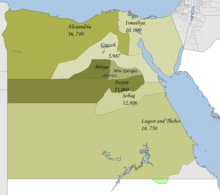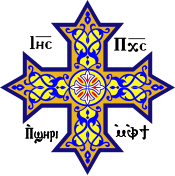Coptic Catholic Church
Coptic Catholic Church | |
|---|---|
 | |
| Classification | Eastern Catholic |
| Polity | Episcopal |
| Structure | Patriarchate |
| Pope | Francis |
| Patriarch | Ibrahim Isaac Sidrak |
| Associations | Congregation for the Oriental Churches |
| Region | Egypt, with communities in Asia, Australia, Europe, and North America |
| Language | Coptic, Arabic |
| Liturgy | Coptic Rite |
| Headquarters | Cathedral of Our Lady of Egypt, Cairo, Egypt |
| Congregations | 166 (2016) |
| Members | 187,320 (2017)[1] |
| Ministers | 243[2] |
| Official website | coptcatholic.net |
| Part of a series on |
| Particular churches sui iuris of the Catholic Church |
|---|
| Particular churches are grouped by liturgical rite |
| Alexandrian Rite |
| Armenian Rite |
| Byzantine Rite |
| East Syriac Rite |
| Latin liturgical rites |
| West Syriac Rite |
|
Eastern Catholic Churches Eastern Catholic liturgy |
| Part of a series on the |
| Copts |
|---|
| Culture |
| Regions |
| Denominations |
|
|
The Coptic Catholic Church[a] is an Eastern Catholic particular Church in full communion with the Catholic Church. Along with the Ethiopian Catholic Church and Eritrean Catholic Church, it belongs to the Alexandrian liturgical tradition. Uniquely among the Alexandrian Rite Eastern Catholic liturgies, the Coptic Catholic Church uses the Coptic Rite and the Coptic language (derived from Ancient Egyptian) in its liturgy; the Ethiopian Catholic Church and Eritrean Catholic Church use the Ge'ez Rite.[4]
The current Coptic Catholic Patriarch of Alexandria is Ibrahim Isaac Sidrak, who replaced Antonios Naguib in 2013. The offices of the patriarchate are located in Cairo. The patriarchal Cathedral of Our Lady of Egypt is in Nasr City, a suburb of Cairo.[citation needed]
History
[edit]Beginnings
[edit]Since the Council of Chalcedon in the 5th century and the official separation of the Coptic Church from the Western Christian and Eastern Orthodox churches, the Catholic Church has attempted to achieve reunion with the Copts in Egypt many times. During the Council of Florence in 1442, the Coptic delegates present agreed to a reunion with the papacy in Rome,[5] but the Coptic populace was opposed to the idea, and the union did not take effect. Further failed attempts at reunion were undertaken by Coptic delegates in 1560 and 1582.[6]
In the 17th century, at the behest of Pope Urban VIII, Catholic missionaries (primarily Franciscans) started to come to Egypt. In 1630, a number of missions of the Capuchin Order were founded in the Levant by Joseph of Paris, including in Cairo.[6] Although the mission in Cairo initially faced setbacks, tensions with the local Coptic priesthood were minimized with the arrival of Capuchin priest Agathangelo of Vendome to the city in 1633.
Initial relations between Catholics and Copts in Egypt were poor. One Coptic councilor in 1637 referred to the Roman Church in Egypt as "a brothel".[6][7] Attempts to excommunicate Catholic offenders in the city were seemingly fruitless.[6] Agathangelo would later be hanged as a martyr in Ethiopia by order of the Ethiopian king in 1638,[7] and the mission in Cairo would start to decline. The Jesuits came in 1675.[8]
In 1741, the Coptic bishop, Anba Athanasius of Jerusalem, became a Catholic. [9] In 1781, he was appointed by Pope Benedict XIV as vicar apostolic of the fewer than 2,000 Egyptian Coptic Catholics.[8] Eventually, Athanasius returned to the Coptic Orthodox Church and others served as Catholic vicar apostolic.[8]
Patriarchate
[edit]Under the assumption that the Ottoman viceroy wanted a Catholic patriarch for the Coptic Catholics in 1824, the Pope established the Patriarchate of Alexandria[8] from the Apostolic Vicariate of Syria, Egypt, Arabia and Cyprus[10] but it was basically titular.[8] The Ottomans in 1829 allowed the Coptic Catholics to build their own churches.[8]
The number of Catholics of this rite increased to the point that Leo XIII in 1895 restored the Catholic patriarchate.[9] He initially named Bishop Cyril Makarios as patriarchal vicar. Makarios then presided over a synod, which led to the introduction of some Latin practices. In 1899, Leo appointed Makarios as patriarch of Alexandria of the Copts, taking the name Cyril II. He resigned in 1908 at the request of the Pope over a controversy. The patriarchate seat remained vacant until an election in 1947[8] and was administered by an apostolic administrator.[10]
Hierarchy
[edit]The Coptic Catholic Church sui juris comprises a single ecclesiastical province, covering Egypt alone. The Patriarch is the sole metropolitan archbishop, retaining the ancient title Alexandria but his actual seat is in Egypt's modern capital Cairo.
Coptic Catholic Church has eight suffragan bishops, throughout Egypt, comprising the only Coptic Catholic ecclesiastical province: Abu Qurqas, Alexandria (Patriarch's original home seat), Assiut, Giza, Ismailia, Luxor, Minya and Sohag.[citation needed]

Religious orders
[edit]The Coptic Catholic Church does not have Coptic monasteries. Instead the Church has religious congregations such as the three communities for women: the Sisters of the Sacred Heart, the Coptic Sisters of Jesus and Mary (both based in Egypt) and the Egyptian Province of the Little Sisters of Jesus. There is also a community of male Franciscans and Jesuits.[8]
Educational and health services
[edit]Most candidates for the priesthood are trained at St. Leo's Patriarchal Seminary, in suburban Cairo. More than 100 Coptic Catholic parishes administer primary schools, and some have secondary schools as well. The church maintains a hospital, a number of medical dispensaries and clinics, and several orphanages.[11]
Ecumenism
[edit]Relations between the Coptic Catholic Church and the larger Coptic Orthodox Church are generally very good.[12]
See also
[edit]- Eastern Catholicism
- List of Catholic dioceses in Egypt
- List of Catholic dioceses (structured view)
- List of Coptic Catholic Patriarchs of Alexandria
- Monasticism
- Oriental Orthodox Church
Notes
[edit]References
[edit]- ^ "The Eastern Catholic Churches 2017" (PDF). Archived from the original (PDF) on 2018-10-24. Retrieved 2019-06-19.
- ^ Roberson, Ronald G. "The Eastern Catholic Churches 2010" (PDF). Eastern Catholic Churches Statistics. Catholic Near East Welfare Association. Archived from the original (PDF) on 23 September 2015. Retrieved 28 December 2011.
- ^ "الكنيسة الكاثوليكية تحتفل بذكرى القديس فالنتينو الأسقف". www.dostor.org. Retrieved 2021-02-14.
- ^ LaBanca, Nicholas (2019-02-19). "The Eastern Catholic Churches: Part 3, the Alexandrian Rite". Ascension Press Media. Retrieved 2025-01-22.
- ^ Curtin, D. P. (January 2007). Laetentur Caeli: Bulls of Union with the Greeks, Armenians, Coptic, and Ethiopian Churches. ISBN 9798869171504.
- ^ a b c d Atiya, Aziz S.; et al., eds. (1991). "Coptic Relations With Rome". Coptic Encyclopedia. Vol. 2. New York: Macmillan Publishing Company. pp. 609–611. ISBN 0028970241.
- ^ a b Butler, Alban; Burns, Paul (1998) [1756]. Herbert, Thruston; et al. (eds.). Butler's Lives of the Saints. Vol. 6 (new full ed.). Kent: Burns & Oates. pp. 50–52. ISBN 0860122573.
- ^ a b c d e f g h Roberson, Ronald G. "The Coptic Catholic Church". Eastern Catholic Churches. Catholic Near East Welfare Association. Retrieved 27 January 2012.
- ^ a b Fortescue, Adrian (1909). . Catholic Encyclopedia. Vol. 5.
- ^ a b "Patriarchal See of Alexandria". Catholic Dioceses in the World. GCatholic.org. Retrieved 27 January 2012.
- ^ "Pontifical Mission - The Coptic Catholic Church". www.cnewa.org. Retrieved 2017-01-20.
- ^ Sprague, Sean. "Upper Egypt's Copts: Coptic Christians strive to improve the lot of all Egyptians". Retrieved 20 September 2020.
Sources and external links
[edit]- Coptic Catholic Patriarchate official website
- Coptic Catholic Church page at Fellowship and Aid to the Christians of the East
- Article on "Life in a Coptic Catholic Village"
- "Italian-language video on the Coptic Catholic Church"
- "Video of the ordination of Coptic Catholic deacons"
- Article on the Coptic Catholic Church by Ronald Roberson on the CNEWA web site
- Common Declaration of Pope Paul VI and Pope Alexandria Shenouda III, 1973
- GigaCatholic



